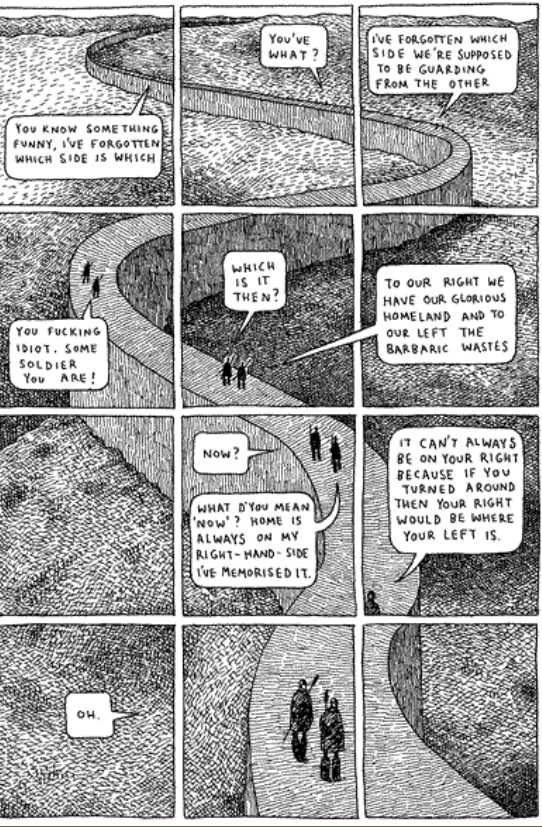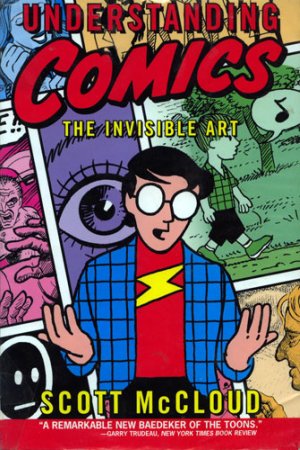Editor’s Note: This is part of a series of student papers from Phillip Troutman’s class at George Washington University focusing on comics form in relation to Scott McCloud’s theories. For more information on the assignment, see Phillip’s introduction here.
__________________
Scott McCloud is quick to introduce the concept of closure as the defining aspect of comics and is nearly as quick to locate it as existing in “the gutter”, the blank space between the panels in comics. This is a useful shorthand, but as he further develops these ideas it becomes clear that closure is actually a continuous involuntary act on the part of the reader that does not rely on the panel or gutter at all. In fact, closure occurs within panels quite frequently and is the result of time being represented, usually implied by sound or motion. As McCloud explains, in a purely visual medium like comics, time, or the motion and sound that implies time, can only be represented through the space on the page. In comics, space and time are the same. This reduces the panel and its negative space, the gutter, to icons that indicate that time and space is being divided. In effect, the panel and gutter have less to do with the actual process of closure, that is, perceiving the whole from parts, and more to do with indicating what is a part.
So as this image from McCloud’s Understanding Comics demonstrates, closure can occur without the use of intervening gutters to indicate the passage of time. As McCloud explains, the movement of our eye across the page is enough for us to understand that time is passing and to make sense of what is happening. Gutters are not necessary. This leads me to conclude that it is the act of scanning the page that generates closure. By scanning I mean the almost involuntary movement of our eyes across the page and the unconscious synthesis of the images on the page into a narrative.
Consider the polyptych, a technique used in Guardians of the Kingdom by Tom Gauld. A polyptych in the comics world is where “a moving figure or figures is imposed over a continuous background” (McCloud pg 115). The polyptych provides an example of closure occurring in one setting, likely with one subject or a small group acting or talking (that is, providing sound or motion to imply time and generate closure), but it is a technique that requires the use of panels as an organizational framework, despite the fact that all the closure-generating action of a character occurring within one setting could only logically be explained as a passage of time. Otherwise it would appear as the sudden multiplication of one character into many copies, something I think it is safe to say could easily be ruled out through context.
For example, this polyptych from Gauld’s aforementioned work uses one scene and only two characters, both moving and speaking and thereby implying the passage of time. It also has a very basic set of panels dividing the image which helps to emphasize and clarify the passage of time. The panels help to organize the image on the page, but they are not necessary to understand the image, which is to say, to generate closure. If there is some doubt about this assertion, imagine the page without the panels. Although it might be momentarily confusing, reading the whole page would provide the necessary context for closure to occur. In fact, in this particular instance, even that much probably wouldn’t be necessary, as the reader would be aware that there are only two characters in this book. Nonetheless, the panels do help and McCloud’s characterization of them as icons for the division of time seems to make sense, although they might be more accurately described as indices. An icon bears a visual similarity to the thing it represents, whereas an index does not necessarily resemble anything, but indicates that what it represents is occurring. As panels and gutters can’t be said to visually resemble the passage of time, but instead indicate that it is happening, they are indices.
Why, if they are not necessary, do we see panels and gutters so often in comics? The answer is that while they are not necessary for closure, they are necessary for comics as a format. They help us to organize the page and are the author’s means of steering our scanning of the images. Imagine, once more, the page above without panels. But this time imagine that it is huge, far larger than any book would allow, so large that it would take some time to scan the whole image from top to bottom. In that case, the winding wall and real time needed to scan the page would provide all the indication of the passage
of time necessary. Closure would certainly occur without the panels. In essence, panels are not necessary for closure; they are an accident of the format that has been developed by authors as a means of directing the process of closure, thereby shaping the meaning we draw from the comic.
There is further evidence to suggest that while closure doesn’t strictly require panels, comics do. More broadly, any visual narrative art requires panels and if those panels are not explicitly drawn, they are implied. The Bayeux tapestry, an 11th century embroidery depicting William the Conqueror’s successful invasion of England, although clearly not a comic in the modern form, works just like one. It combines images, definitively on the iconic side of the spectrum, and words to tell a story. It scans from left to right and is
broken down into a number of scenes, although none are explicitly numbered or
otherwise differentiated. But the fact remains that the panels are implied. The need for organization in the images was still present and panels, or in this case scenes, are apparently the instinctual way to depict this.
It is my contention that closure occurs constantly through our scanning of the images and the involuntary creation of meaning out of the juxtaposed images on the page. The panels and their negative space, the gutters, act only as a way of organizing these images for, no doubt according to the author, more meaningful scanning. Further, I would argue that panels are actually just a formalization of our natural scanning and is due mostly to the physical format that comics take. The fact that comics generally come in books, that
is on pages read left to right, top to bottom, has necessitated the use of panels. Specifically it solves the problem of moving down the page, something the Bayeux tapestry doesn’t have to deal with and consequently didn’t create a system like explicit panels to direct the reader. I do not disagree with McCloud that “closure is comics”, indeed any visual narrative must have closure because that’s how we make sense of them. And I would go farther, perhaps, than McCloud by stating that comics are panels, whether those panels are implied or explicit, because the format demands it. But, as I believe I have shown, there is no transitive property at work here; panels and their gutters are comics, comics is closure, but panels and gutters are not closure.



